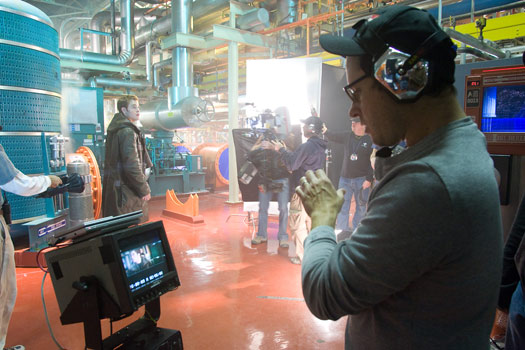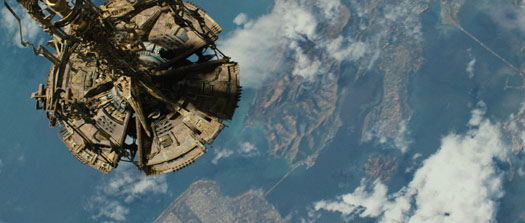How J.J. Abrams Demanded, and ILM Delivered, More Story from Every Shot

“Overhead light dutch angle of Enterprise in the middle of massive debris field. Enterprise barreling through it.”
Another black card appears:
“Camera is behind the Enterprise and a giant piece of black dish is heading for it.”
Then, another:
“Side angle Enterprise drops down below the dish. It barely misses them.”
“These black cards were all over the place,” Kavanagh says. “We’re like, ‘Oh, the shot changed.’ And J. J. would say, ‘Yeah, but it’s so much better, isn’t it?’ And, it really was. He was telling a better story, or making the story more personal, or showing a conflict within, and he would be really smart about doing that. But we had to redo about half the shots. The third act was just black card after black card after black card, cut with some live action.” And by then, the previs team was long gone.

Usually, at ILM, the pipeline works like this: the layout department receives background plates ‘ the footage shot on location ‘ or, for all-digital shots, the previs. From those sources, match-move and layout artists derive the camera moves and lens information to give animators 3D scenes viewed through a virtual camera that matches footage shot on set, or the approved previs. But the black cards meant the layout artists and animators needed to design the shots as well as create them. And on a tight schedule.
“We had from May ’08 until October/November ’08,” says Guyett, “because we were still on a Christmas release schedule. And in a space movie, you have large parts that don’t exist, which means there are many decisions.”
With all that in mind, Kavanagh decided to compress the pipeline. “I thought that we had to work as efficiently as possible or we would be spinning our wheels for a long time,” he says. “We needed to get multiple takes to J. J. quickly and get him to agree. So I combined layout and animation into one department for the show. I picked animators who had done cameras and layout artists keen to animate.”
All told, the team, which at the peak included 18 artists, animated shots with around 15 spaceships, two creatures, the Enterprise, the seven-mile long Romulan mining vessel called the Narada, and some digital doubles.
For the black-card shots, Kavanagh assigned sequences to artists in his new department who handled the work from previs to final animation. “We did something like 70 shots for the third act in five days,” Kavanagh says. “And we took them, almost to final, to LA and presented them to J. J. We came back with about 60 percent headed in the right direction and hammered again, hard, to take them to final. By doing the previs in our pipeline, the shots were almost ready to go.”

Colin Benoit, a layout artist at ILM, was one of the people who moved into Kavanagh’s neo-animation department and became the animation sequence lead for the “space jump” sequence. In this sequence, Sulu, Kirk, and a red-shirted ensign named Olson jump down through space from their shuttle following a kind of umbilical cord that extends from the Narada, a huge Romulan ship, to a mining platform 1000 feet above the surface of Vulcan. When the villains pull the platform back to their ship, Sulu slips off. Because his parachute doesn’t open, Kirk jumps after him, and they free-fall to the surface of Vulcan.
One slice of the pie-shaped platform was a set piece. ILM created the rest of the platform, the seven-mile-long, claw-like Narada, the umbilical cord, the plasma drill that extends from the platform to the planet, the planet itself, the surrounding environment, and digital doubles as needed to match the actors skydiving on wires on a greenscreen set.
Although the fast-paced action makes the sequence move quickly, it comprises almost a third of the film. Benoit and his team, which included as many as three layout artists and three animators at times, started with the previs animatics when they could and the ubiquitous black cards when they couldn’t. To help quickly design the black card shots, Benoit used an orientation sensor.
“It’s a little device from Xsens, a gyroscope and magnetometer about two or three inches long and three inches high, that gave us orientation control at our desk,” Benoit says. By plugging the Xsens device into a USB port, the shot designers could plot the position of the camera and the pan, tilt and roll in real time.
“It was like I was looking through a real camera,” Benoit says. “I could watch all the 3D geometry, everything in 3D space, the characters fly by, the umbilical cord, the Narada, the drill platform, all optimized to play back in realtime.”
By holding the device in his hand, Benoit could move the camera through all three degrees of freedom while watching the footage. “I’d let the footage loop and do multiple takes,” he says. “I could crank out 10 or 15 takes, pick the best one, tweak it if I wanted, and render it out. I showed the device to J. J. and he was very excited. Sometimes, it’s hard to interact so directly with CG. This bridges that gap.”

The combination of layout and animation worked so well that the studio is planning to use the same system for future shows. “Animation could have done all the camera work themselves, but I think that having people in layout doing the cameras is very important, so I’m glad Paul brought me and the others into the department,” Benoit says. “We have people on our team who were camera operators on The Empire Strikes Back.”
Even though Benoit hasn’t been a camera operator, after having match-moved the cameras in hundreds of shots while working in the layout department for post-production work on films at ILM since 2002, he has learned more than a few moves.
“[To match-move,] you have to understand exactly what the camera operator is doing with what type of camera,” he says. “Technocrane vs Spydercam vs dolly, pan, tilt. You have to know before you start a match move. I think that doing camera work that blends properly with real footage, going from practical to digital [and] back to practical, is an art form that’s gradually becoming more and more important.”
For Kavanagh, the experiment proved that the studio could promote its previs capability as well as its post-production skills. “We have good artists who aren’t afraid of that daunting blank scene in Maya,” he says. “And, like a lot of studios, we’re looking at how we can make our own previs department cost-effective.”
Did you enjoy this article? Sign up to receive the StudioDaily Fix eletter containing the latest stories, including news, videos, interviews, reviews and more.










Leave a Reply